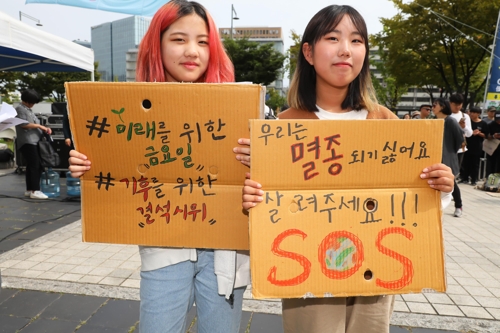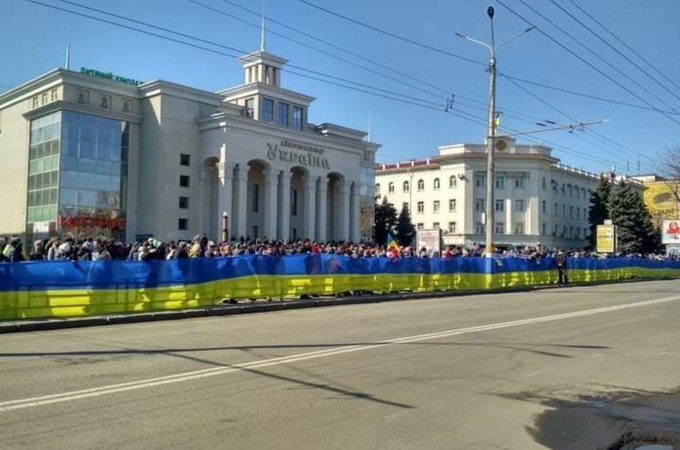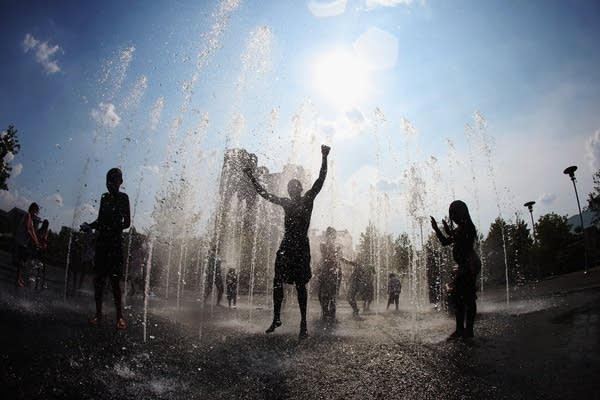뉴스&스피킹(영자신문)
하루 10분이면 영어에 대한 두려움을 극복하고 누구나 유창하게 영어를 구사하실 수 있습니다.
-
 South Korean Court Hears Climate Change Case Against Government South Korea's Constitutional Court has begun hearing a case that accuses the government of failing to protect 200 people by not dealing with climate change.
South Korean Court Hears Climate Change Case Against Government South Korea's Constitutional Court has begun hearing a case that accuses the government of failing to protect 200 people by not dealing with climate change.
The case, which began Tuesday in Seoul, includes many young environmental activists and children.
The people bringing the legal action, or the plaintiffs, said the case was Asia's first climate-related case. It includes four petitions by children and babies among others dating from 2020. There is also a petition from a fetus at the time the case was brought to court, nicknamed “Woodpecker.”
Lee Jongseok said climate lawsuits are getting popular around the world and are gaining public interest. Lee is the president of the court, which is one of the highest in South Korea.
"The court recognizes the importance and public interest of this case and will make efforts to ensure that deliberations are conducted thoroughly," he said.
Earlier this month, Europe's human rights court ruled on another climate-related case. The court found the Swiss government had violated its citizens' rights by not doing enough to combat climate change. Courts in Australia, Brazil and Peru are also hearing similar cases.
The plaintiffs said in a statement that South Korea’s climate plans are not enough to keep the world’s average temperature increase within 1.5 degrees Celsius of “pre-industrial” levels. The government’s failure violates “fundamental rights," the statement said.
Climate scientists say if the average world temperature rises more than 1.5 degrees Celsius, there will be results that cannot be changed. These scientists say large ice sheets will melt and ocean currents will stop.
Burning of fossil fuels, such as oil, gas and coal, results in carbon emissions. These warm gases are being blamed for the warming of the land and sea. South Korea's economy depends on fossil fuels for growth. However, South Korea has sought to reach carbon neutrality by 2050.
Government lawyers told the court that the government was doing everything possible to reduce carbon emissions and not violate the basic rights of its people. They added that the government did not discriminate against young people, and there could be changes to yearly goals on carbon reduction.
Several activists said the government's answer was disappointing.
A group of young people, including Woodpecker, who is now one year old, gathered outside the court. Some criticized what they called the government's inaction on climate change.
"Carbon emission reduction keeps getting pushed back as if it is homework that can be done later," said the baby’s mother, Lee Donghyun. "But that burden will be what our children have to bear eventually."
The mother of one eight-year-old plaintiff said her children live in fear of the effects of climate change.
"Because there's a mountain behind our house, the kids say our house can get hit by a landslide. And who knows? That can happen," she said.
Last year, South Korea lowered its 2030 targets for greenhouse gas reductions. But it kept its national goal of cutting emissions by 40 percent of 2018 levels, calling the move a reasonable change.
I’m Dan Novak.View -
 What Happened When India Banned TikTok The hugely popular Chinese app TikTok may be forced out of the United States. Wednesday, President Joe Biden signed into law a conditional ban of the video-sharing app.
What Happened When India Banned TikTok The hugely popular Chinese app TikTok may be forced out of the United States. Wednesday, President Joe Biden signed into law a conditional ban of the video-sharing app.
India banned TikTok almost four years ago. Here is a look at what happened there.
Why did India ban TikTok?
In June 2020, TikTok users in India said goodbye to the app, operated by Chinese internet company ByteDance. India banned the popular app suddenly, following a deadly military clash with India along their shared border. India banned many other Chinese apps at the same time. Ties between the two Asian countries hit a new low.
The Indian government said it ordered the ban for security reasons and privacy protection. The Indian public mostly supported the ban.
The message from the government was, “how can we allow Chinese companies to do business in India when we’re in the middle of a military standoff,” said Nikhil Pahwa. He is a digital policy expert and founder of technology news website MediaNama.
Just months before the ban, India restricted investment by Chinese companies, Pahwa added. “Today, India has banned over 500 Chinese apps to date,” he said.
How did users and creators react?
At the time, India had about 200 million TikTok users, the most outside of China. The company also employed thousands of Indians.
TikTok users and content creators, however, needed a place to go. Within months, Google created YouTube Shorts and Instagram created its Reels feature. Both were similar to the short-form video creation that TikTok is known for.
Pahwa said those companies captured “most of the market that TikTok had vacated.”
Winnie Sangma misses posting videos on TikTok and earning a bit of money. But after the ban, he moved to Instagram and now has 15,000 followers.
“I have built up followers on Instagram too, and I am making money from it, but the experience isn’t like how it used to be on TikTok,” he said.
How India’s ban is different from the U.S.
The U.S. measure gives ByteDance, the app’s parent company, nine months to sell it. If this does not happen, TikTok will be banned. It would take at least a year before the ban goes into effect. However, the measure is expected to face legal battles that could delay the process.
In India, the process was quick. TikTok and other companies were given time to answer questions on privacy and security. But, by January 2021, a permanent ban was in place.
The situation in the U.S. is different, said Pahwa. “In India, TikTok decided not to go to court, but the U.S. is a bigger revenue market for them.”
Pahwa added that with American free speech protections “it’s not going to be as easy for the U.S. to do this as it was for India.”
As Chinese apps spread across the world, Pahwa says countries should reduce their dependence on Chinese companies. He said Chinese apps can create a national security risk.
Afghanistan, Nepal and Pakistan also banned TikTok. Many countries in Europe restrict the app as well.
“Chinese intelligence law and its cybersecurity law can allow Chinese apps to work in the interest of their own security. That creates a situation of distrust and it becomes a national security risk for others,” said Pahwa.
“There should be different rules for democratic countries and for authoritarian regimes where companies can act as an extension of the state,” he added.
I’m Dan Novak.View -
 Are You the Windshield or the Bug? On our good days, we reach our goals. We get things done. On those kinds of days, we are taking care of business. We are killing it! On those days we are the windshield.
Are You the Windshield or the Bug? On our good days, we reach our goals. We get things done. On those kinds of days, we are taking care of business. We are killing it! On those days we are the windshield.
But then our luck changes. Things don’t go our way. We may be down in the dumps or just down on our luck. For whatever reason, we are not at the top of our game. On these days, we are the bugs.
This expression is very informal. So, it is not very serious. Similar expressions include “peaks and valleys.” Peaks are high while the valleys are low. You can also say “you win some, you lose some.” And sometimes we refer to life as a “rollercoaster ride.” Rollercoasters are famous for their high climbs and sharp drops.
Now let’s hear two people use some of these expressions in a short conversation.
A: Hey, what’s wrong? You look a little down.
B: I just got some bad news from project I'm working on. And things were going so well.
A: Well, you know what my Grandma Gardenia used to say, “Some days you’re the windshield and some days you’re the bug.”
B: Today I’m definitely the bug.
A: I’m sure things will look better tomorrow. Granny Gardenia also used to say, “you win some, you lose some.”
B: You know … you’re right. We all go through tough times.
A: That’s the spirit! (sighs) Every time I hit a rough patch, Granny Gardenia would say, "Don’t let a little setback get you down. Tomorrow is a new day!"
B: Thanks for the encouragement. I appreciate it.
A: Don't thank me. Thank my grandma. It's impossible to be down in the dumps around Granny Gardenia.
The British band Dire Straits has a song about the subject of life’s good times and bad. It's called The Bug. The song reminds us that we should enjoy the good times because they are temporary. As the song goes: sometimes you’re the windshield/sometimes you’re the bug.
Do you have a similar expression in your language? Let us know in the comments section or send us an email at LearningEnglish@voanews.com.
And that’s all the time we have for this Words and Their Stories. Until next time, I’m Anna Matteo.
Anna Matteo wrote this lesson for VOA Learning English.View -
 Berdiansk: Ukrainian City at Crossroads Editor's note: This story is one of the winning entries from the "Teach Us about Ukraine" writing contest sponsored by VOA Learning English and GoGlobal.
Berdiansk: Ukrainian City at Crossroads Editor's note: This story is one of the winning entries from the "Teach Us about Ukraine" writing contest sponsored by VOA Learning English and GoGlobal.
Berdiansk is a Ukrainian city on the northern coast of the Azov Sea.
In peacetime, the resort city attracts people from all over the world who come to gain energy from the sun and the sea. During the war, it became a city of resistance, a place of hope for Ukrainians who found themselves under Russian occupation.
Berdiansk was founded in 1827, but according to archaeologists, life here was in full swing in the days of the Scythians, Greeks, Polovtsians, and Nogai. Herodotus, an ancient Greek historian, admired the lands while recalling his travels along the Azov Sea.
Townspeople love to tell the story of the origin of the city’s name. Berda means "god-given, rich" in Turkic. At first, Berda was the name of the local river, and then the city was named after it, Berdiansk.
But the story goes back to the time of the Nogai, a Turkish ethnic group, which inhabited the southern part of Ukraine in the 1500s. An old nomadic leader named Berdy fell in love with a beautiful horsewoman, Tanai, who did not return his love and ran away to throw herself into the sea. The nomadic leader ordered a path made out of stones in the sea to catch the fleeing horsewoman. Tanai disappeared from the horizon. She did not drown but turned into a white-winged seagull. Now, a figure of a seagull girl is installed near the Museum of History of Berdiansk.
During peacetime, visitors come to the city during the summer and enjoy its many bars, discos, and cafes. There is the Safari Zoo with 140 species of animals and Aqualand, an entertainment complex. And its spiritual life includes Orthodox, Catholic, and German Lutheran churches.
The most famous person born in Berdiansk is Volodymyr Khavkin, a 19th-century scientist who developed vaccines against plague and cholera. His contemporaries were Opanas Slastion, the artist who depicted Ukrainian history and life, and Trokhym Zinkivsky, who wanted to revive the Ukrainian nation.
One of the city's landmarks is the main building of Berdiansk University. Built in 1872, the building looks like the Hogwarts School of Witchcraft and Wizardry from the Harry Potter books. The medieval-style detail and red brick towers make it seem as if wizards really study there.
The city has monuments to summer residents who cultivated the land and the Nursing Bull who saved locals from starvation during World War II. There is a statue of a plumber climbing out of a manhole, a symbol of human vices, and the famous “wishing chair,” where Ukrainians undoubtedly wish for victory against invaders.
The Upper Lighthouse, built in 1877, is one of the oldest lighthouses in Ukraine. It is still shining into the Azov Sea waiting for ships to return to the harbor. During peacetime, merchant ships flew the flags of many countries docked in Berdiansk, the largest port on the Azov Sea.
Russian troops have occupied the port city since February 2022. The city, known for its beaches and beautiful sunsets, is now filled with Russian troops and their military equipment.
In April 2022, RFE/RL reported that “Russian personnel had occupied the government buildings and transformed them into their bases of operation…There was no natural gas or mobile phone coverage. Food, medicine, and fuel were in short supply. Explosions could be heard in the distance, and the occupying forces had appointed a ‘commandant’ from among their military ranks to act as mayor.”
The Russian military also took over schools, churches, and businesses. The Ukrainian language is banned, and people are being tortured.
Ukrainians, however, continued to fight and several died as a result. Valeriy Chibineev, known as Karakurt, died near Gostomel on his 34th birthday while performing a special mission. And teenagers, Nikita Khanganov and Tigran Ohannisyan, were killed by the Russian military for their pro-Ukrainian position.
Last May, Ukrainian forces destroyed several Russian warships in the port. In a statement, Ukrainian armed forces said: “In the Azov operational zone…a large landing ship Saratov was destroyed during the attack on the occupied Berdiansk port.” The attack also damaged two other Russian vessels, Caesar Kunikov and Novocherkassk. Satellite images confirmed the sinking of the Saratov.
I'm Anna MatteoView -
 Climate Agencies: Europe Is Fastest-warming Land Mass A new report from two international climate agencies has found that Europe is the fastest-warming major land mass in the world.
Climate Agencies: Europe Is Fastest-warming Land Mass A new report from two international climate agencies has found that Europe is the fastest-warming major land mass in the world.
The report for 2023 is a product of the United Nation’s World Meteorological Organization and the European Union’s climate agency, Copernicus. The document states that parts of Spain, France, Italy and Greece reported up to ten days of extreme heat stress in 2023.
Heat stress measures a mix of environmental effects on the human body in an effort to establish a “feels like” temperature. This level is defined as a temperature that feels like more than 46 degrees Celsius. Health experts say heat stress can present immediate risks of heat stroke and other conditions
Elisabeth Hamdouch is a member of the EU’s executive commission and works on Copernicus activities. She told the Associated Press Europe’s heat stress last year was marked by “record temperatures, wildfires, heat waves, glacier ice loss and lack of snowfall.”
The report said that temperatures in Europe are currently rising at about twice the worldwide average. Deaths related to heat in Europe have increased by about 30 percent over the last 20 years, it said. Last year, the researchers said more than 150 lives were directly lost in connection with storms, floods and wildfires.
“Hundreds of thousands of people were affected by extreme climate events in 2023,” said Carlo Buontempo, director of Copernicus’ Climate Change Service. He added that the climate effects were responsible for economic losses across Europe estimated to be “at least in the tens of billions of euros.”
Last month, Copernicus urged governments to prepare healthcare systems for the increasing effects of climate change. It also called on the EU to establish rules to protect outdoor workers from extreme heat.
The report noted that the release of greenhouse gases was the biggest cause of last year's exceptional heat. Other environmental effects also played a part in the high temperatures, including the El Niño current in the Pacific Ocean.
El Niño is a warming of surface temperatures in the eastern and central Pacific Ocean. This event usually causes hot, dry weather in Asia and Australia and also can drive weather changes in other parts of the world.
The report noted that severe heat can fuel other extreme weather, including flooding. A warmer atmosphere can hold more moisture, possibly causing more rain if the right conditions exist.
In Slovenia, floods affected 1.5 million people last year. Greece suffered the EU's biggest wildfire on record, reportedly stretching 960 square kilometers. And mountain glaciers shrank about 10 percent during 2022 and 2023, the report said.
Copernicus’ Buontempo said, "Some of the events of 2023 took the scientific community by surprise because of their intensity, their speed of onset, extent and duration."
Copernicus reported that March marked the 10th straight month of record monthly temperatures. The agency has reported record world temperatures every month since last June. The latest report said the average sea surface temperature for ocean areas across Europe reached its highest yearly level in 2023.
I’m Bryan Lynn.View
